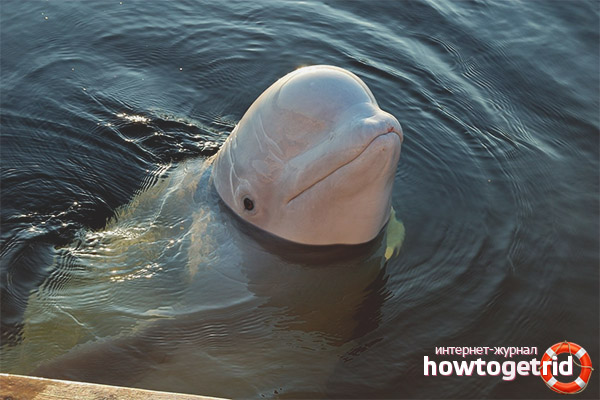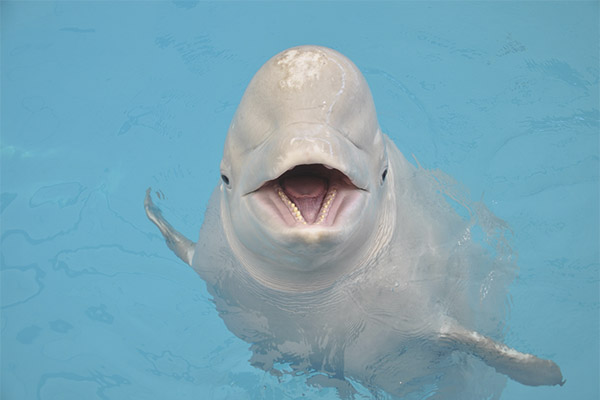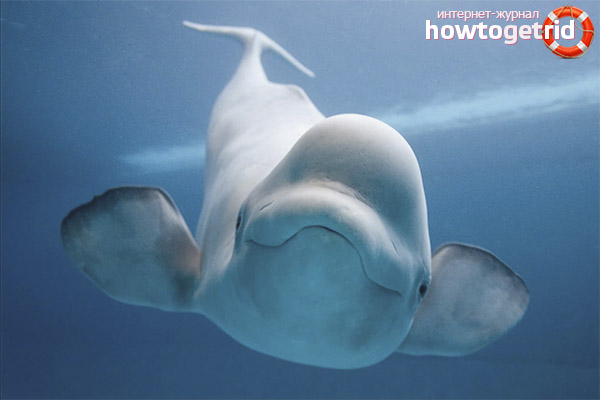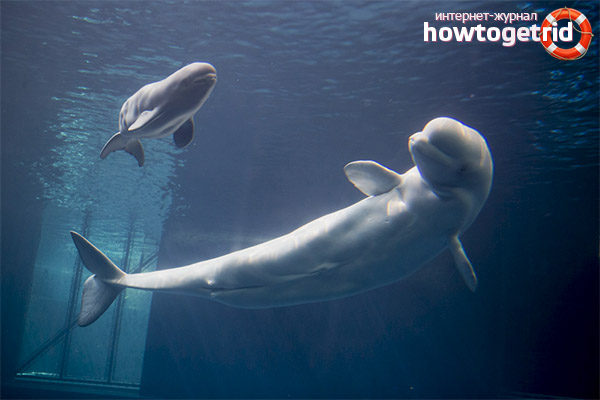The content of the article
What is a white whale - a whale or a dolphin? About this animal goes a huge number of legends. Some sources rank among dolphins, nodding at outward signs. Others persistently call the whale, claiming it is of enormous size! So the white whale has two names - “singing whale” and “polar dolphin”.
Description and appearance
Belukha is a mammal from the family of Narwhal, a subspecies of toothed whales, but often because of those places where it dwells, it is considered a dolphin. Three species inhabit the territory of Russia - Far Eastern, Kara, and White Sea belugas.
A large animal is up to 6 meters long and weighs about 2 tons. Females a little smaller.
The color changes over the years - in newborn animals the color of the body is blue-black, after a year it becomes much paler,acquires a gray or bluish-gray hue, after three or five years the animal becomes sexually mature, the blue turns faded and disappears, the belugas become completely white (that's why they call them that). This color remains forever.
The head is small, but a large forehead protrudes on it. Many whales do not know how to rotate their heads, because the vertebrae are one whole - merged with each other. And in the white whale they are separated by cartilage, so the whale can turn its head where necessary. The facial muscles are very mobile and often it seems that the face expresses some feelings - joy, delight, contempt or resentment.
Pectoral fins are not very large, oval. Dorsal fin beluga without. Because among the ices this detail can be superfluous and will interfere.
The skin is very thick (up to 2 centimeters) and durable, there is a fatty layer under it, sometimes reaching a thickness of up to 15 centimeters, which serves as animal heat insulation.
Habitat, nature
Lifestyle
Belugas are gregarious animals. A flock consists of groups. Groups are different - in one the female and her offspring can live, in the other - several adult males. The whole life of belugas is seasonal migrations, depending on the season.
In winter, when the coastal part binds the ice, belugas go into the depths of the sea, where there is less ice and there are non-freezing areas where you can swim and get fresh fish. If the frost is very strong, move to the southern areas. In the spring, they return closer to the coast.
Belugas, like other dolphins, are very attached to the place where they were born, and return there every year.
Nutrition
The diet of the white whale is very rich, but the main course is fish holding in flocks - cod, herring, flounder, tuna, capelin. Especially loves salmon - ready for this fish to swim anywhere.It is in pursuit of salmon that the beluga often swims into rivers.
The way of catching and catching fish is truly whale: the water along with the prey is sucked in, the food is swallowed, and the water is ejected back into the ocean.
Belugas are excellent hunters, and food is obtained by gathering in a group of 4-5 individuals. With such joint efforts, animals drive prey to small areas, where they catch it. In addition to fish, food is served by many types of worms, crustaceans, mollusks.
Breeding and children
Males become sexually mature at 7 years, females much earlier at 4 years. The mating period lasts depending on the habitat - from mid-April to June. Usually for love joys calm places are chosen on the coast. During mating games, the males literally fight for the attention of the females, arranging the real battles in the water. A female as a partner chooses a winner, and then pairing takes place.
Pregnant females form groups in which they hold the entire gestation period until they give birth. They give birth in the coastal zone in warm waters. There is usually one baby born, although sometimes (but extremely rarely) there are twins.After 13-14 months a small dolphin is born. Deliveries take place tail forward. Its length up to one and a half meters, immediately born to the light, the baby floats to the surface and takes the first breath. Mother feeds her large cub (up to 80 kilograms at birth) with milk, and she does it for a long time - from one to two years.
The enemies
The white whale has only two main natural enemies in nature. The most dangerous on the water is the killer whale. The beast is hardy and fast, swims much faster than the white whale, so there is practically no chance to escape from it, being far from the coast. As a rule, in such chases, when the killer whale catches up with the beluga whale suffers defeat and becomes a victim.
The second enemy is the polar polar bear. During the wintering period, the predator catches belugas in the coastal waters near the ice-holes and, when the whale emerges after another batch of life-giving air, the shaggy predator kills the animal with a paw blow, providing itself with fatty, nourishing food for a long time.
Another enemy can be called a man. Toxic wastes discharged by enterprises into the ocean and sea waters have a bad effect on animals.Because of this, flocks have to migrate very far, where animals just freeze.
Habits

Belugas have good eyesight - they can see both under water and above it, but they prefer to orient themselves in the water with the help of signals issued in the ultrasonic range - they return by the returned echo that they are in front of a barrier or a school of fish. But besides this, white whales are capable of making up to fifty very loud sounds: there may be birds chirping, squeaks in various tonalities, screaming, gnashing, whistling, other sounds resemble a growl. Sounds, like most animals, serve to communicate between members of a group. Mimicry they learned to use for the same purpose.
Moult
In the spring, belugas begin to molt - old skin will fall down from them, replacing it with a new one. Belugs in the process of molting are involved very actively - they creep out onto the land and rub against coastal pebbles and pebbles, helping the skin to peel. That slips large patches.
Man and white whale
Because of the ingrained habit of the white whales to migrate along the same routes, whales used to become easy prey for whale meat hunters.The animals were driven into the shallows, about which they were divided. In a similar brutal way, several hundred of these individuals were destroyed. Or they used other methods - for example, they blocked the movement with nets and networks. They hunted because the whales were famous for soft meat, strong, durable hide, high-quality whale oil and the so-called whalebone.
In the modern world, hunting is prohibited, the animal is listed in the Red Book.
Differences of white whales from other whales
- Beluk can be tamed and trained. What man uses, creating dolphinariums, where dolphins live in conditions as close as possible to the natural environment. With the help of trainers, they learn various tricks and arrange performances. They are also being taught underwater photography, which helps in the exploration of the Arctic.
- Belugas are not only good hunters, but also excellent divers. Only under water, these whales can not spend much time - no more than 10-15 minutes. They need to emerge every few minutes to the surface to stock up on another portion of air.
- In order to maintain normal life, adult belugas should eat at least 15 kilograms of food per day.
- Sometimes beluga whales get into ice captivity, but with ice no more than 7 centimeters thick, animals easily break through with a strong back.
- Belugas migrate collectively and gather in colonies, sometimes huge - up to a thousand individuals.
- Belugas can swim not only on the tummy, like most fish, but also on the back. They also get good tail sailing forward.
- The speed with which the white whale usually swims is 4-10 kilometers per hour. But the frightened whale develops much greater speed - up to 22 kilometers per hour.
- They live in nature for 30-35 years, but in dolphinariums this period is longer by 5 to 10 years.
Often, these whales because of their ability to sing and make different sounds are called "sea canaries." For the same reason, the phrase "belug beluga" went.
Video: white whale (Delphinapterus leucas)













To send